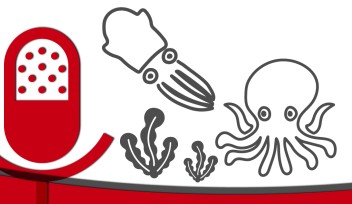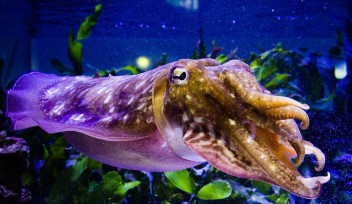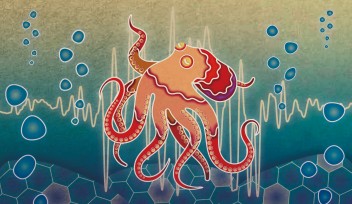Cephalopods in Mind

Neuroscience, the study of the brain, and ethology, the study of animal behavior, constitute the blossoming, interdisciplinary field of neuroethology.
“When scientists examine the brain, we don’t study it in isolation, but rather, in the context of behavior – much of neuroscience is actually neuroethology,” said Professor Sam Reiter, the head of the newly formed Computational Neuroethology Unit at the Okinawa Institute of Science and Technology Graduate University (OIST).
Reiter and his colleagues hold a special interest in coleoid cephalopods: squid, cuttlefish, and octopuses. “Researchers have found that cephalopod brains are capable of sophisticated processes like episodic memory,” Reiter explained. “They’re exhibiting amazingly complex behaviors underpinned by neural architecture that is radically different from that of humans.”
Reiter, who came to OIST in October of 2019 from the Max Planck Institute for Brain Research, uses experimental and computational techniques to study cephalopods. Through his research, he hopes to shed light on the brain function underpinning these animals’ behaviors and perceptual faculties.

Prior to coming to OIST, Reiter earned his PhD in neuroscience at Brown University in the United States. Over the course of his postdoctoral studies, his interests shifted toward exploring intersections of neuroscience and animal behavior.
In his previous work, Reiter was taking electrophysiological recordings of reptile brains, observing that reptiles experienced two distinct stages of sleep. These stages appear to be homologous to rapid eye movement (REM) sleep and non-REM sleep in mammals. In mammals, two-stage sleep has been implicated in memory consolidation among other functions. Reptiles diverged evolutionarily from humans hundreds of millions of years ago, indicating that these two stages of sleep are incredibly ancient.
While this work was progressing, Reiter became increasingly interested in the cuttlefish living nearby the reptiles in his lab.
The secrets of camouflage
Now at OIST, Reiter is interested in studying cuttlefish sleep (they have exhibited sleep-like behavior), but also, how they camouflage their bodies to elude predators.
Cuttlefish have a special proclivity for camouflage – nearly instantaneously, they can alter the texture, color, and pattern of their skin to blend into elaborate, colorful backgrounds.
Millions of chromatophores – specialized pigment cells studding the animal’s skin – orchestrate cuttlefish camouflage. These cells are encircled by muscles that contract and expand in response to input from motor neurons in the brain; thus, the movement of chromatophores is tied directly to brain processes. Reiter is interested in recording chromatophore dynamics as a readout of the neural activity underpinning this behavior.

Reiter and his colleague, Dr. Gilles Laurent from Max Planck Institute for Brain Research, recently published an article in Current Opinions in Neurobiology on the relationship between textural perception and camouflage in cuttlefish. According to Reiter, studying camouflage may provide greater insight into how the animals’ visual systems differentiate between textures in their environment.
When humans visually perceive scenery, the brain groups this scenery into textural patterns to extrapolate its important elements. Reiter suspects that textural perception is not unique to humans – or even to mammals. Cuttlefish perception could possibly work in a similar way.
Reiter is now taking detailed video footage of cuttlefish to study chromatophore activity. In addition, he is harnessing up-and-coming technologies like machine learning and supercomputing to analyze this chromatophore activity quantitatively.
“We want to understand just how cuttlefish select backgrounds to camouflage to,” said Reiter. “This may give us insight into the mechanisms of their visual perception – as well as the visual perception of the predators hunting them.” These questions will continue to inspire his research at OIST.
Specialties
Research Unit
For press enquiries:
Press Inquiry Form
















